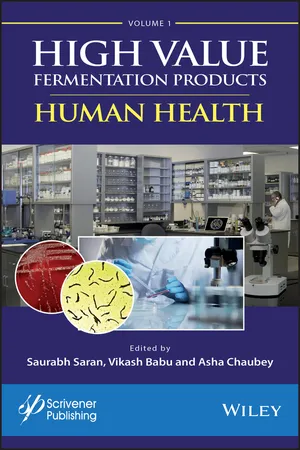
High Value Fermentation Products, Volume 1
Human Health
- English
- ePUB (mobile friendly)
- Available on iOS & Android
About This Book
Green technologies are no longer the "future" of science, but the present. With more and more mature industries, such as the process industries, making large strides seemingly every single day, and more consumers demanding products created from green technologies, it is essential for any business in any industry to be familiar with the latest processes and technologies. It is all part of a global effort to "go greener, " and this is nowhere more apparent than in fermentation technology.
This book describes relevant aspects of industrial-scale fermentation, an expanding area of activity, which already generates commercial values of over one third of a trillion US dollars annually, and which will most likely radically change the way we produce chemicals in the long-term future. From biofuels and bulk amino acids to monoclonal antibodies and stem cells, they all rely on mass suspension cultivation of cells in stirred bioreactors, which is the most widely used and versatile way to produce. Today, a wide array of cells can be cultivated in this way, and for most of them genetic engineering tools are also available. Examples of products, operating procedures, engineering and design aspects, economic drivers and cost, and regulatory issues are addressed. In addition, there will be a discussion of how we got to where we are today, and of the real world in industrial fermentation. This chapter is exclusively dedicated to large-scale production used in industrial settings.
Frequently asked questions
Information
Chapter 1
Introduction, Scope and Significance of Fermentation Technology
Abstract
1.1 Introduction
1.2 Background of Fermentation Technology
Table of contents
- Cover
- Title page
- Copyright page
- Foreword
- About the Editors
- List of Contributors
- Preface
- Acknowledgement
- Chapter 1: Introduction, Scope and Significance of Fermentation Technology
- Chapter 2: Extraction of Bioactive Molecules through Fermentation and Enzymatic Assisted Technologies
- Chapter 3: Antibiotics Against Gram Positive Bacteria
- Chapter 4: Antibiotic Against Gram-Negative Bacteria
- Chapter 5: Role of Antifungal Drugs in Combating Invasive Fungal Diseases
- Chapter 6: Current Update on Rapamycin Production and its Potential Clinical Implications
- Chapter 7: Advances in Production of Therapeutic Monoclonal Antibodies
- Chapter 8: Antimicrobial Peptides from Bacterial Origin: Potential Alternative to Conventional Antibiotics
- Chapter 9: Non-Ribosomal Peptide Synthetases: Nature’s Indispensable Drug Factories
- Chapter 10: Enzymes as Therapeutic Agents in Human Disease Management
- Chapter 11: Erythritol: A Sugar Substitute
- Chapter 12: Sugar and Sugar Alcohols: Xylitol
- Chapter 13: Trehalose: An Anonymity Turns Into Necessity
- Chapter 14: Production of Yeast Derived Microsomal Human CYP450 Enzymes (Sacchrosomes) in High Yields, and Activities Superior to Commercially Available Microsomal Enzymes
- Chapter 15: Artemisinin: A Potent Antimalarial Drug
- Chapter 16: Microbial Production of Flavonoids: Engineering Strategies for Improved Production
- Chapter 17: Astaxanthin: Current Advances in Metabolic Engineering of the Carotenoid
- Chapter 18: Exploitation of Fungal Endophytes as Bio-Factories for Production of Functional Metabolites through Metabolic Engineering; Emphasizing on Taxol Production
- Index
- End User License Agreement